The Influence of Vibration and Moisture Content on the Compactness of the Substrate in Nursery Container Cells Determined with a Multipenetrometer
Abstract
:1. Introduction
2. Materials and Methods
3. Results
4. Discussion
5. Patents
6. Conclusions
- The prototype multipenetrometer measuring station allowed for the rapid measurement of substrate compactness in multiple cells of the container. This capability enables the quick quality control of container filling by the automatic line and assessment of the operators’ performance.
- Increasing substrate moisture and vibration intensity had a significant impact on substrate compaction and its variability within the container cells. This effect was indicated by an increase in both compactness and bulk density, along with a decrease in the variability of these parameters.
- With higher moisture levels and vibration intensity, there was a notable increase in penetration resistance and bulk density, and the variability of these parameters decreased more significantly in the cells of V300 containers (with a larger cell volume of 265 cm3) compared to V150 containers (with a cell volume of 145 cm3).
- The study confirmed the optimal parameters for filling V150 and V300 containers using a peat–perlite substrate on the Urbinati Ypsilon automated line, which operates at a capacity of approximately 400 containers h−1. The ideal settings are a moisture level of approximately 75% and a vibration set to the maximum level of G.
Author Contributions
Funding
Data Availability Statement
Acknowledgments
Conflicts of Interest
References
- Rolbiecki, S.; Musiał, M.; Fórmaniak, A.; Ryterska, H. Próba porównania potrzeb nawadniania szkółek leśnych w latach 2000–2009 w okolicach Bydgoszczy, Chojnic i Tomnia. An attempt to compare the needs of forest nursery irrigation in the years 2000–2009 in the vicinity of Bydgoszcz, Chojnice and Toruń. Infrastruct. Ecol. Rural Areas 2010, 14, 23–30. (In Polish) [Google Scholar]
- Leciejewski, P. Nawodnienia w Szkółkach Leśnych. Irrigation of Forest Nurseries. Biblioteczka Leśniczego; SITLiD Publishing House: Warsaw, Poland, 2011; Volume 330, pp. 1–14. (In Polish) [Google Scholar]
- Szabla, K.; Pabian, R. Szkółkarstwo Kontenerowe: Nowe Technologie i Techniki w Szkółkarstwie Leśnym. Container Nursery. New Technologies and Techniques in Forestry Nursery; State Forests Information Centre: Warsaw, Poland, 2003; p. 212. ISBN 83–88478–43–5. (In Polish) [Google Scholar]
- Cabrera, P.I.; Johnson, J.R. Fundamentals of container media management: Part 1. In Greenhouse and Nursery Crops Fact Sheets & Bulletins; Rutgers Fact sheet FS 812; The State University of New Jersey: New Brunswick, NJ, USA, 2014; p. 3. [Google Scholar]
- De Boodt, M.; Verdonck, O. The Physical Properties of the Substrates in Horticulture. Acta Hortic. 1972, 26, 37–44. [Google Scholar] [CrossRef]
- Fernandes, C.; Cora, J.E. Bulk density and relationship air/water of horticulture substrate. Sci. Agric. 2004, 61, 446–450. [Google Scholar] [CrossRef]
- Paquet, J.M.; Caron, J.; Banton, O. In situ determination of the water desorption characteristics of peat substrates. Can. J. Soil. Sci. 1993, 73, 339–349. [Google Scholar] [CrossRef]
- Bilderback, T.; Warren, S.; Owen, J.; Albano, J.P. Healthy substrates need Physicals too! HortTechnology 2005, 15, 747–751. [Google Scholar] [CrossRef]
- Cook, A.; Bilderback, T.; Lorscheider, M. Physical property measurementsin container substrates: A field Quantification strategy. SNA. Res. Conf. 2004, 49, 102–104. [Google Scholar]
- Allaire, S.E.; Caron, J.; Duchesne, I.; Parent, L.É.; Rioux, J.A. Air–filled porosity, gas relative diffusivity, and tortuosity: Indices of Prunus ×Cistena sp. growth in peat substrates. J. Amer. Soc. Hort. Sci. 1996, 121, 236–242. [Google Scholar] [CrossRef]
- Strojny, Z. Podłoże w pojemnikowej produkcji szkółkarskiej. Substrate in container nursery production. Nursery 2003, 4, 61–67. (In Polish) [Google Scholar]
- Mathers, H.M.; Yeager, T.H.; Case, L.T. Improving irrigation water use in container nurseries. HortTechnology 2005, 15, 8–12. [Google Scholar] [CrossRef]
- Evans, M.R.; Gachukia, M.M. Physical properties of sphagnum peat– based root substrates amended with perlite or parboiled fresh rice hulls. HortTechnology 2007, 17, 312–315. [Google Scholar] [CrossRef]
- Altland, T.E.; Owen, J.O.; Gabriel, M.Z. Influence of Pumice and Plant Roots on Substrate Physical Properties. HortTechnology 2011, 21, 554–557. [Google Scholar] [CrossRef]
- Kormanek, M.; Małek, S.; Banach, J.; Jagiełło-Leńczuk, K.; Dudek, K. Seasonal changes of perlite–peat substrate properties in seedlings grown in different sized container trays. New For. 2021, 52, 271–283. [Google Scholar] [CrossRef]
- Kremer, J.; Matthies, D.; Borchert, H. The impact of different carriages on soil and roots—Wheels and tracks in comparison. Meeting the Needs of Tomorrows’ Forests—New Developments in Forest Engineering. In Proceedings of the 9 Austro 2007/FORMEC’07, AU, Vienna and Heiligenkreuz, Austria, 7–11 October 2007; pp. 1–9. [Google Scholar]
- Wang, J.I. Terramechanics and Off-Road Vehicle Engineering: Terrain Behaviour, Off-Road Vehicle Performance and Design; Butterworth-Heinemann: Oxford, UK, 2009; p. 397. ISBN 9780080942537. [Google Scholar]
- Lee, J.-S.; Kim, S.Y.; Hong, W.-T.; Byun, Y.-H. Assessing subgrade strength using an instrumented dynamic cone penetrometer. Soils Found. 2019, 59, 930–941. [Google Scholar] [CrossRef]
- Kormanek, M.; Walczyk, M.; Walczyk, J. Wpływ obciążenia i liczby przejazdów ciągników zrywkowych na zmianę zwięzłości wybranych gleb leśnych. The effect of load and number of passes of skidding tractors on compaction of forest soils. Sylwan 2008, 10, 48–55. (In Polish) [Google Scholar] [CrossRef]
- Kormanek, M.; Dvořák, J. Ground Pressure Changes Caused by MHT 8002HV Crawler Harvester Chassis. Crojfe J. For. Eng. 2021, 42, 201–211. [Google Scholar] [CrossRef]
- Kormanek, M.; Dvořák, J. Use of Impact Penetrometer to Determine Changes in Soil Compactness after Entracon Sioux EH30 Timber Harvesting. Crojfe J. For. Eng. 2022, 43, 13. [Google Scholar] [CrossRef]
- ASAE S313.3 Published FEB1999 (R2018); ASAE Standards Soil Cone Penetrometer. American Society of Association Executives: Washington, DC, USA, 1999; pp. 820–821.
- Herrick, J.E.; Jones, T.L. A dynamic cone penetrometer for measuring soil penetration resistance. Soil Sci. Soc. Am. J. 2002, 66, 1320–1324. [Google Scholar] [CrossRef]
- Kees, G. Hand—Held Electronic Cone Penetrometers for Measuring Soil Strength; USDA Forest Service Technology and Developement Prgram: Missoula, MT, USA, 2005; p. 13.
- De Moraes, M.T.; Da Silva, W.R.; Zwirtes, A.L.; Carlesso, R. Use of penetrometers in agriculture: A review. Eng. Agric. Jaboticabal. 2014, 34, 179–193. [Google Scholar] [CrossRef]
- Allaire-Leung, S.E.; Caron, J.; Parent, L.E. Changes in physical properties of peat substrates during plant growth. Can. J. Soil Sci. 1999, 79, 137–139. [Google Scholar] [CrossRef]
- Lipiec, J.; Hajnos, M.; Świeboda, R. Estimating effects of compaction on pore size distribution of soil aggregates by merkury porosimeter. Geoderma 2012, 179−180, 20–27. [Google Scholar] [CrossRef]
- Kormanek, M.; Banach, J.; Sowa, P. Effect of soil bulk density on forest tree seedlings. Int. Agrophys. 2015, 29, 67–74. [Google Scholar] [CrossRef]
- Kormanek, M.; Głąb, T.; Banach, J.; Szewczyk, G. Effects of soil bulk density on sessile oak Quercus petraea Liebl. seedlings. Eur. J. For. Res. 2015, 134, 969–979. [Google Scholar] [CrossRef]
- Gajda, A.; Przewłoka, B. Soil biological activity as affected by tillage intensity. Int. Agrophys. 2012, 26, 15–23. [Google Scholar] [CrossRef]
- Abawi, G.S.; Widmer, T.L. Impact of soil health management practices on soilborne pathogens, nematodes and root diseases of vegetable crops. Appl. Soil Ecol. 2000, 15, 37–47. [Google Scholar] [CrossRef]
- Marshall, V.G. Impacts of forest harvesting on biological processes in northern forest soils. For. Ecol. Manag. 1999, 133, 43–60. [Google Scholar] [CrossRef]
- Sands, R.; Bowen, G.D. Compaction of sandy soils in radiata pine forests. II. Effects of compaction on root conRycination and growth of radiata pine seedlings. Aust. For. Res. 1978, 8, 163–170. [Google Scholar] [CrossRef]
- Banach, J.; Małek, S.; Kormanek, M.; Durło, G. Growth of Fagus sylvatica L. and Picea abies (L.) Karst. Seedlings Grown in Hiko Containers in the First Year after Planting. Sustainability 2020, 12, 7155. [Google Scholar] [CrossRef]
- Pająk, K.; Małek, S.; Kormanek, M.; Banach, J. Effect of peat substrate compaction on growth parameters and root system morphology of Scots pine Pinus sylvestris L. seedlings. Sylwan 2022, 166, 2537–2550. [Google Scholar] [CrossRef]
- Pająk, K.; Kormanek, M.; Małek, S.; Banach, J. Effect of Peat-Perlite Substrate Compaction in Hiko V265 Trays on the Growth of Fagus sylvatica L. Seedlings. Sustainability 2022, 14, 4585. [Google Scholar] [CrossRef]
- Kleibl, M.; Klvac, R.; Lombardini, C.; Porhaly, J.; Spinelli, R. Soil compaction and recovery after mechanized final felling of Italian coastal Pine Plantations. Crojfe J. For. Eng. 2014, 35, 63–71. [Google Scholar]
- Cambi, M.; Certini, G.; Neri, F.; Marchi, E. The impact of heavy traffic on forest soils: A review. For. Ecol. Manag. 2015, 338, 124–138. [Google Scholar] [CrossRef]
- Jones, D.; Kunze, M. Guide to Sampling Soil Compaction Using Hand-Held Soil Penetrometers; CEMML TPS 04-1; Center for Environmental Management of Military Lands (CEMML), Colorado State University: Fort Collins, CO, USA, 2004; pp. 1–8. [Google Scholar]
- Vanags, C.; Minasny, B.; McBratney, A.B. The dynamic penetrometer for assessment of soil mechanical resistance. Super soil AU, 2004, Published on CDROM. Available online: https://www.regional.org.au/au/asssi/ (accessed on 9 July 2023).
- Vaz, C.M.P.; Manieri, J.M.; De Maria, I.C.; Tuller, M. Modeling and correction of soil penetration resistance for varying soil water content. Geoderma 2011, 166, 92–101. [Google Scholar] [CrossRef]
- Raper, R.L.; Washington, B.H.; Jarrell, J.D. Technical notes: A tractor-mounted multiple-probe soil cone penetrometer. Appl. Eng. Agric. 1999, 15, 287–290. [Google Scholar] [CrossRef]
- Voltcraft DL-131G. USB Vibration Logger DL 131G. Operating Instruction. Version 08/13. Voltcraft 2013. 2. Available online: https://asset.conrad.com/media10/add/160267/c1/-/pl/000419329ML04/manual-419329-voltcraft-dl-131g-acceleration-data-logger-unit-of-measurement-vibrationacceleration-18-up-to-18-g.pdf (accessed on 10 June 2023).
- Kormanek, M.; Małek, S.; Mateusiak, Ł.; Banach, J.P. 441918 Stanowisko Pomiarowe do Badania Zwięzłości Podłoża w Kontenerach, Zwłaszcza Szkółkarskich Zgłoszenie Patentowe. Measuring Stand for Testing the Compactness of the Substrate in Containers, Especially Nursery Containers. Patent Pending P.441918, 2 August 2022. (In Polish). [Google Scholar]
- Rabiej, M. Statystyka z Programem Statistica. Statistics with the Program; Helion: Warszawa, Poland, 2012; p. 344. (In Polish) [Google Scholar]
- StatSoft. Electronic Statistics Manual. Krakow, PL. 2006. Available online: http://www.statsoft.pl/textbook/stathome.html (accessed on 14 July 2023).
- Raport o stanie lasów w Polsce 2021. Report on the Condition of Forests in Poland 2021; State Forests Information Center: Warszawa, Poland, 2022; p. 162. ISSN 1641–3229. (In Polish) [Google Scholar]
- Pająk, K.; Małek, S.; Kormanek, M.; Jasik, M. The effect of peat substrate compaction on the macronutrient content of Scots pine Pinus sylvestris L. container seedlings. Sylwan 2022, 166, 211–223. [Google Scholar] [CrossRef]
- Caron, J.; Elric, C.E.; Michel, J.C.; Naasz, R. Physical properties of organic soils and growing media: Water and air storage and flow dynamics. In Soil Sampling and Methods of Analysis, 2nd ed.; Carter, M.R., Gregorich, E.G., Eds.; CRC Press: Boca Raton, FL, USA, 2007; pp. 885–912. ISBN 13 978-0-8493-3586-0. [Google Scholar]
- Vannieuwenhuizen, K. Effects of Soil Compaction on the Germination and Growth of Picea Mariana and Pinus Banksiana. Master’s Thesis, Faculty of Natural Resources Management, Lakehead University, Thunder Bay, Ontario, CA, USA, 2020; p. 66. Available online: http://knowledgecommons.lakeheadu.ca/handle/2453/4634 (accessed on 14 July 2023).
- Soureshjani, H.K.; Bahador, M.; Tadayon, M.; Dehkordi, A.G. Modelling seed germination and seedling emergence of flax and sesame as affected by temperature, soil bulk density, and sowing depth. Ind. Crops Prod. 2019, 141, 111770. [Google Scholar] [CrossRef]
- Boylan, N.; Long, M.; Mathijssen, F.A.J.M. In situ strength characterisation of peat and organic soil using full-flow penetrometers. Can. Geotech. J. 2011, 48, 1085–1099. [Google Scholar] [CrossRef]
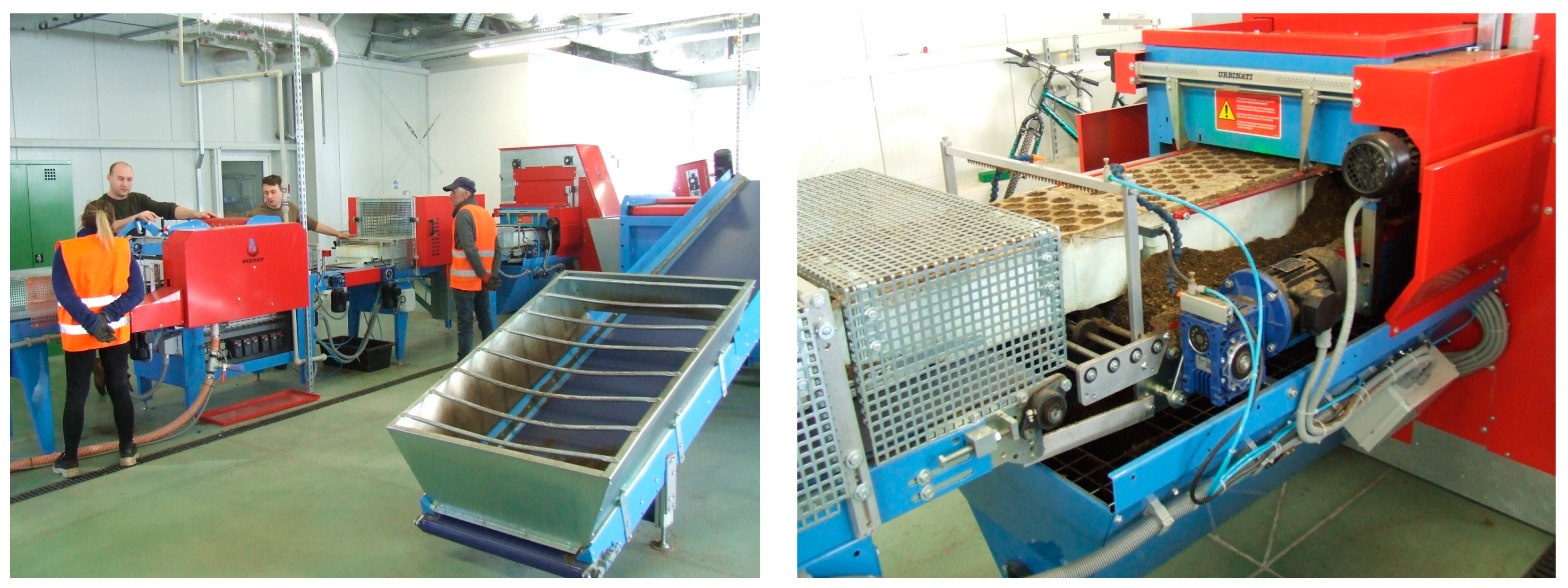

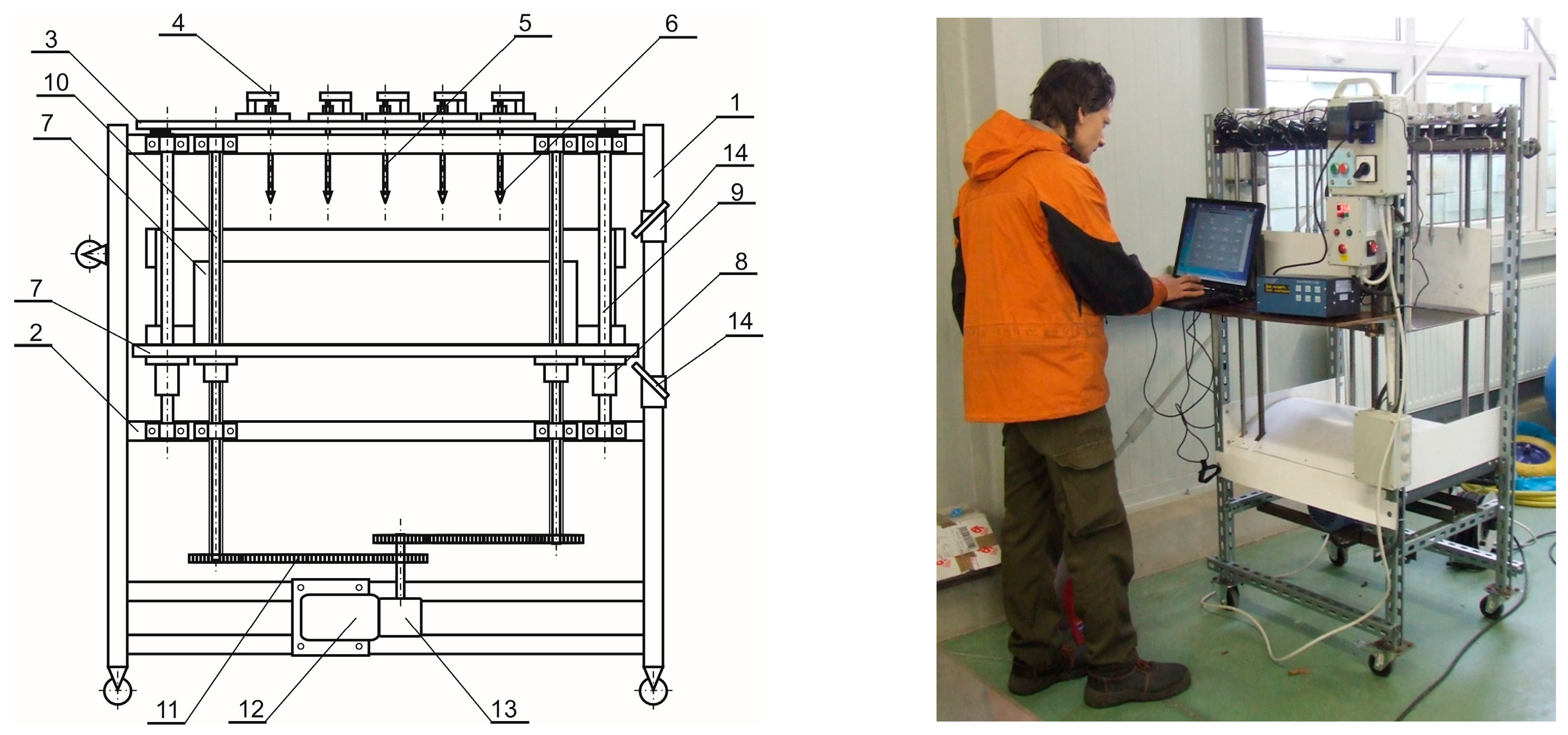
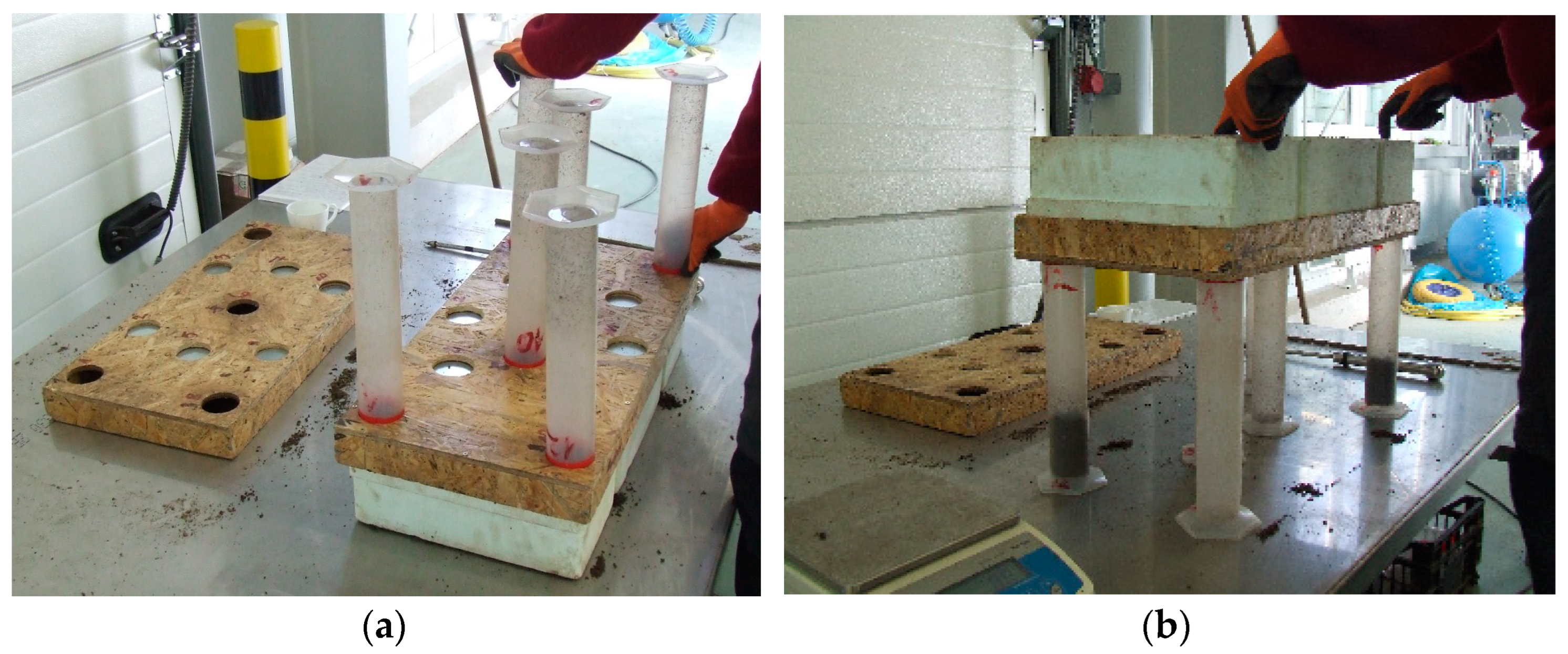
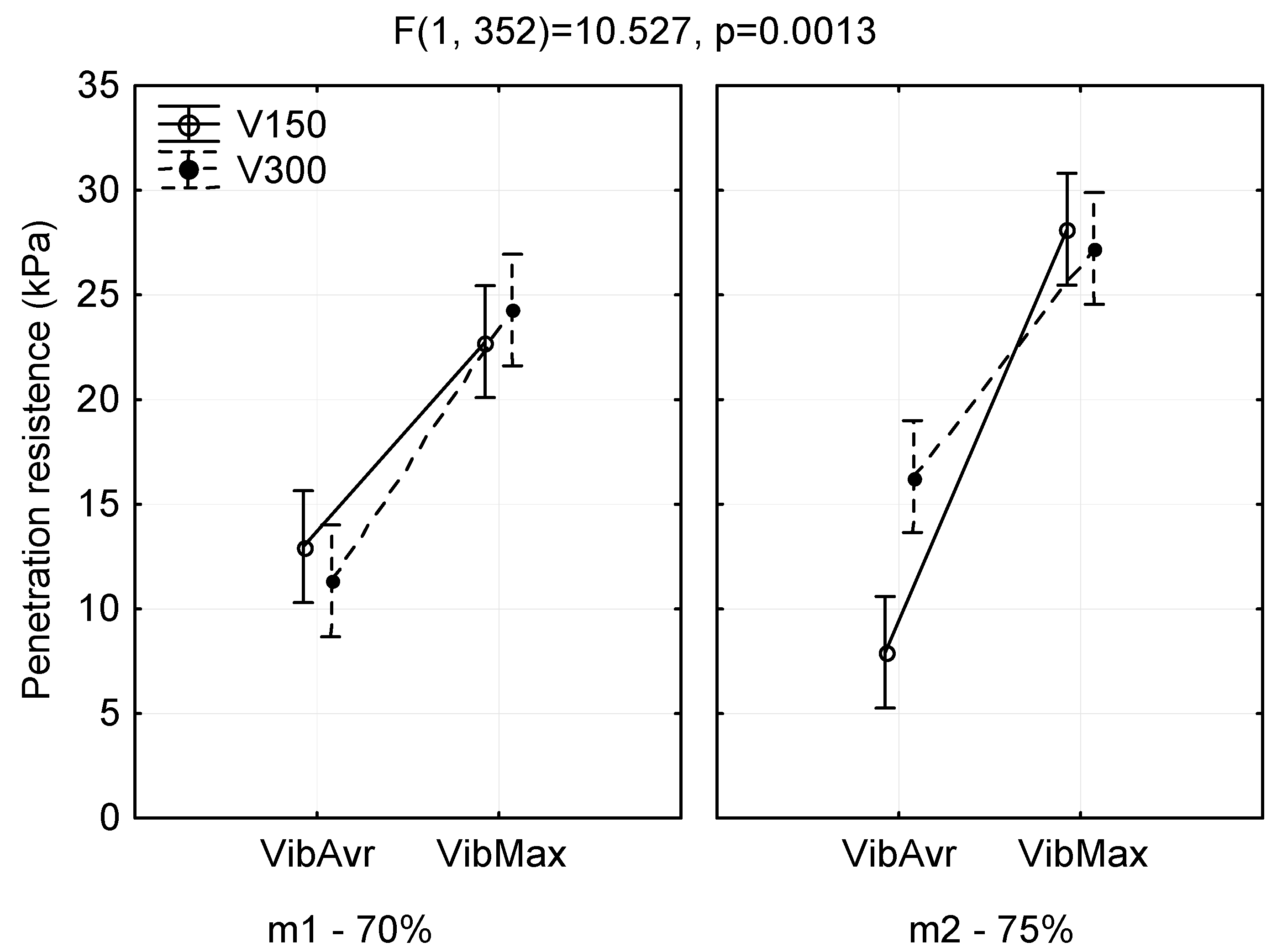
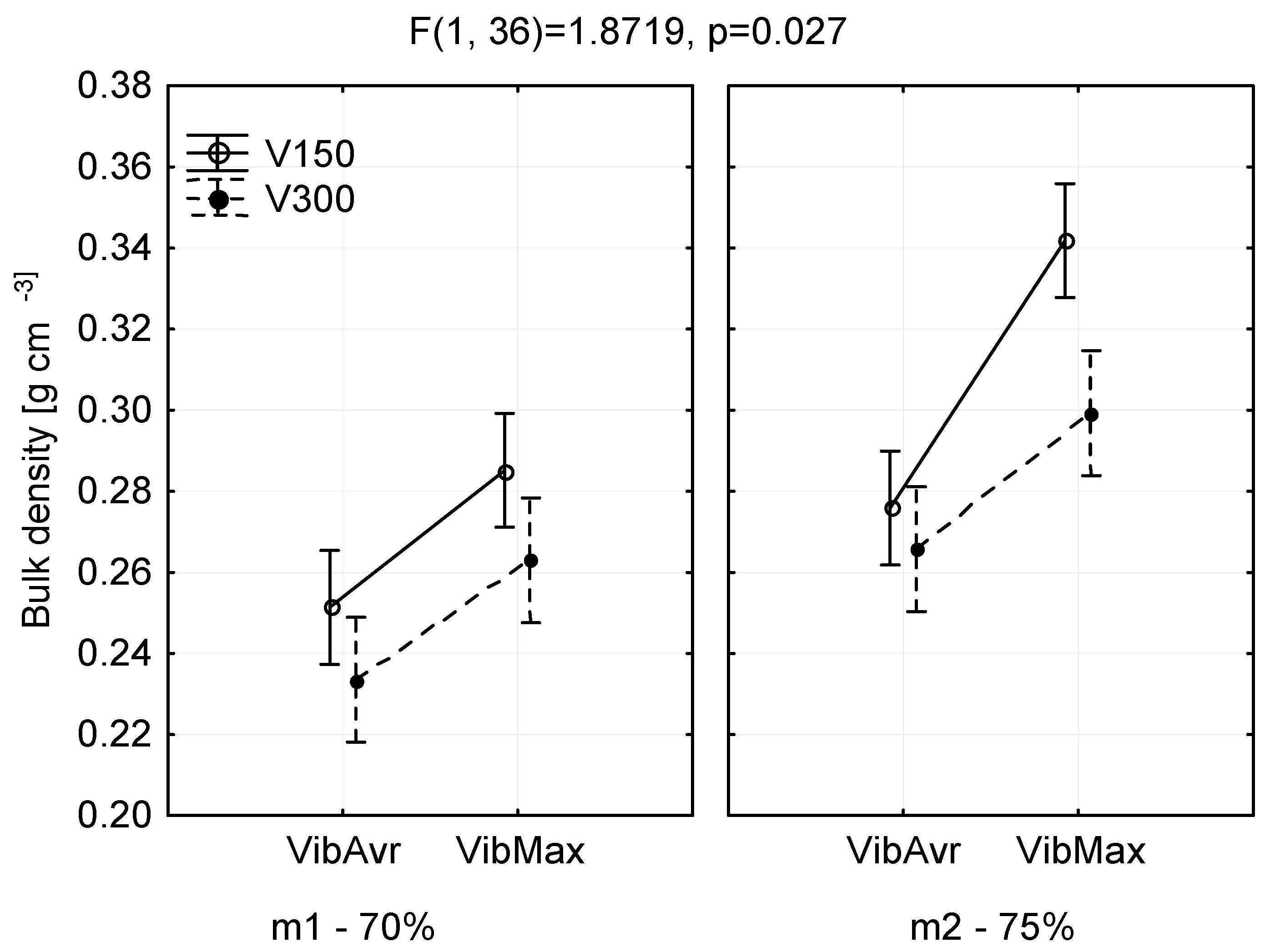

| Parameter | V150 | V300 |
|---|---|---|
| Length/width/height | 650/312/150 mm | 650/312/180 mm |
| Number of cells | 74 pc. | 53 pc. |
| Cell volume | 0.145 dm3 | 0.275 dm3 |
| Cell opening diameter | 5.3 cm | 4.6 cm |
| Substrate Parameters | Factor | |||||||
|---|---|---|---|---|---|---|---|---|
| Container Type | Substrate Moisture | Vibration Intensity | Container Repeat | |||||
| F-Test | p | F-Test | p | F-Test | p | F-Test | p | |
| Penetration resistance (kPa) | 3.486 | 0.063 | 4.392 | 0.037 * | 186.910 | <0.001 ** | 0.586 | 0.557 |
| Bulk density (g∙cm3) | 3.495 | 0.062 | 4.402 | 0.366 | 187.340 | <0.001 ** | – | – |
| Moisture Variant | Vibration Variant | Value | Penetration Resistance [kPa] | Bulk den. [g∙cm−3] | |||
|---|---|---|---|---|---|---|---|
| Container | C1 | C2 | C3 | C1–C3 | C4 | ||
| m1 70% | VibAvr | Average | 12.6 | 15.0 | 11.3 | 12.97 | 0.234 |
| St. dev. | 8.5 | 6.9 | 5.8 | 7.1 | 0.012 | ||
| Coef. of var. [%] | 67.2 | 46.0 | 51.6 | 54.5 | 4.95 | ||
| VibMax | Average | 27.4 | 16.7 | 24.2 | 22.8 | 0.263 | |
| St. dev. | 11.2 | 13.0 | 11.4 | 11.9 | 0.010 | ||
| Coef. of var. [%] | 40.7 | 77.7 | 47.2 | 52.1 | 3.88 | ||
| m2 75% | VibAvr | Average | 9.5 | 7.3 | 7.1 | 7.9 | 0.276 |
| St. dev. | 5.3 | 4.5 | 4.8 | 4.8 | 0.026 | ||
| Coef. of var. [%] | 55.9 | 61.7 | 67.4 | 61.1 | 9.53 | ||
| VibMax | Average | 30.0 | 25.7 | 28.8 | 28.1 | 0.342 | |
| St. dev. | 10.2 | 11.1 | 12.3 | 11.2 | 0.012 | ||
| Coef. of var. [%] | 34.2 | 43.3 | 42.7 | 39.9 | 3.46 | ||
| Moisture Variant | Vibration Variant | Value | Penetration Resistance [kPa] | Bulk den. [g∙cm−3] | |||
|---|---|---|---|---|---|---|---|
| Container | C1 | C2 | C3 | C1–C3 | C4 | ||
| m1 70% | VibAvr | Average | 12.8 | 8.9 | 12.4 | 11.34 | 0.251 |
| St. dev. | 5.1 | 3.3 | 4.9 | 4.4 | 0.012 | ||
| Coef. of var. [%] | 40.1 | 37.3 | 39.2 | 39.0 | 4.7 | ||
| VibMax | Average | 22.3 | 26.9 | 23.6 | 24.3 | 0.285 | |
| St. dev. | 10.5 | 10.5 | 6.5 | 9.2 | 0.021 | ||
| Coef. of var. [%] | 47.2 | 38.9 | 27.3 | 37.7 | 7.3 | ||
| m2 75% | VibAvr | Average | 14.4 | 18.6 | 15.9 | 16.3 | 0.266 |
| St. dev. | 6.2 | 11.7 | 8.0 | 8.6 | 0.029 | ||
| Coef. of var. [%] | 42.9 | 62.9 | 50.5 | 53.0 | 10.9 | ||
| VibMax | Average | 27.8 | 27.4 | 26.5 | 27.2 | 0.299 | |
| St. dev. | 9.1 | 10.0 | 8.0 | 9.0 | 0.009 | ||
| Coef. of var. [%] | 32.6 | 36.4 | 30.2 | 33.1 | 3.1 | ||
| Factor | Bulk Density | |||||
|---|---|---|---|---|---|---|
| V150 | V300 | V150 and V300 | ||||
| r | p | r | p | r | p | |
| Penetration resistance | 0.250 | 0.024 * | 0.480 | 0.032 * | 0.327 | 0.030 * |
| Container | V150 | V300 | V150 and V300 | |||
|---|---|---|---|---|---|---|
| Moisture Content [%] | ||||||
| r | p | r | p | r | p | |
| Penetration resistance [kPa] | −0.094 | 0.663 | 0.181 | 0.446 | 0.181 | 0.446 |
| Bulk density [g∙cm−3] | 0.529 | 0.007 * | 0.677 | 0.001 * | 0.677 | 0.002 * |
| Vibration intensity [m∙s−2] | ||||||
| Penetration resistance [kPa] | 0.602 | 0.000 ** | 0.570 | 0.000 ** | 0.583 | 0.000 ** |
| Bulk density [g∙cm−3] | 0.655 | 0.001 * | 0.623 | 0.003 * | 0.596 | 0.000 ** |
Disclaimer/Publisher’s Note: The statements, opinions and data contained in all publications are solely those of the individual author(s) and contributor(s) and not of MDPI and/or the editor(s). MDPI and/or the editor(s) disclaim responsibility for any injury to people or property resulting from any ideas, methods, instructions or products referred to in the content. |
© 2023 by the authors. Licensee MDPI, Basel, Switzerland. This article is an open access article distributed under the terms and conditions of the Creative Commons Attribution (CC BY) license (https://creativecommons.org/licenses/by/4.0/).
Share and Cite
Kormanek, M.; Małek, S.; Banach, J. The Influence of Vibration and Moisture Content on the Compactness of the Substrate in Nursery Container Cells Determined with a Multipenetrometer. Forests 2023, 14, 1750. https://doi.org/10.3390/f14091750
Kormanek M, Małek S, Banach J. The Influence of Vibration and Moisture Content on the Compactness of the Substrate in Nursery Container Cells Determined with a Multipenetrometer. Forests. 2023; 14(9):1750. https://doi.org/10.3390/f14091750
Chicago/Turabian StyleKormanek, Mariusz, Stanisław Małek, and Jacek Banach. 2023. "The Influence of Vibration and Moisture Content on the Compactness of the Substrate in Nursery Container Cells Determined with a Multipenetrometer" Forests 14, no. 9: 1750. https://doi.org/10.3390/f14091750
APA StyleKormanek, M., Małek, S., & Banach, J. (2023). The Influence of Vibration and Moisture Content on the Compactness of the Substrate in Nursery Container Cells Determined with a Multipenetrometer. Forests, 14(9), 1750. https://doi.org/10.3390/f14091750





